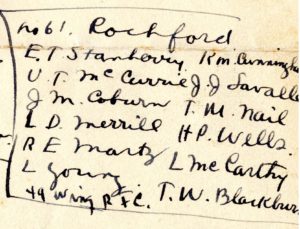(Cane Hill, Arkansas, April 26, 1892 – San Antonio, Texas, September 27, 1964).1
Thomas Welch Blackburn, Sr., was a physician and surgeon in Arkansas.2 His son attended Oklahoma State University and, from 1914 to 1917, worked for Wagner Electric and Manufacturing Co., in St. Louis and then Commonwealth Steel Company in Illinois.3 He was in R.O.T.C. at Fort Sheridan, Illinois, when he registered for the draft.4 He attended ground school at the University of Illinois, graduating September 1, 1917.5
Along with most of the men from his ground school class of about thirty, Blackburn chose or was chosen to go to Italy for flying training and thus sailed as one of the 150 men of the “Italian” or “second Oxford detachment” to England on the Carmania. They departed New York on September 18, 1917, and made a brief stopover at Halifax where they joined a convoy for the Atlantic crossing. When they docked at Liverpool on October 2, 1917, they learned that they were not to go to Italy, but to stay in England. They travelled to Oxford where they spent the month of October repeating ground school. On November 3, 1917, most of the detachment, including Blackburn, went to Grantham in Lincolnshire to attend gunnery school at Harrowby Camp. He initially trained with a group that included Joseph Kirkbride Milnor, who kept a photo of them. Fifty of the men departed on November 19, 1917, for flying schools; Blackburn was among the men who remained at Grantham.

Two weeks later, according to a list of “Cadets of Italian Detachment Posted Dec 3rd” drawn up by detachment member Fremont Cutler Foss, Blackburn went with eleven others ((James Mitchell Coburn, Kenneth MacLean Cunningham, John Lavalle, Roy Edwin Martz, Leo McCarthy, Uel Thomas McCurry, Linn Daicy Merrill, Thomas M. Nial, Elwood D. Stanbery, Horace Palmer Wells, and Louis McComas Young) to No. 61 Squadron at Rochford in Essex; 61 was a home defense squadron flying S.E.5a’s.6 Some of the men, perhaps all, were quickly reassigned to No. 198 Night Training Squadron, which shared the airfield with No. 61 and which had Avros for training purposes.6a If Blackburn was among those reassigned, then, judging by the account of his fellow cadet McCurry, he would have received extensive initial training at No. 198.6b
By late March Blackburn had completed enough flying to be recommended for his commission. Pershing’s cable forwarding the recommendation is dated March 25, 1918; the confirming cable is dated April 5, 1918.7 I have not been able to document his subsequent activities before July 1918 when Blackburn, along with a number of other second Oxford detachment men, was ordered to the 3rd Aviation Instruction Center at Issoudun, France, which would suggest he was to train on DH-4s. After that there is another long gap in the records until November 11, 1918, when he is listed as a ferry pilot. After the armistice, Blackburn was assigned to the U.S. 25th Aero Squadron.8 Sloan, in his Wings of Honor, indicates that Blackburn may for a time have been with the U.S. 141st and 138th Aero Squadrons in early 1919.9
After the war Blackburn remained in the Air Service and Air Force, serving in various capacities, and retiring in 1952 with the rank of brigadier general.10
mrsmcq April 26, 2017
Notes
(For complete bibliographic entries, please consult the list of works and web pages cited.)
1 Dates and places of Blackburn’s birth and death are taken from “Brigadier General Thomas W. Blackburn.” The photo is a detail from one taken of 25th Aero officers shortly after the amistice. I am grateful to Steve Russell for a scan of the photo. The original was apparently part of a collection of photos belonging to Donald Swett Poler that passed into the possession of Jack Cammon Moses and thence to Russell. See “25th Pursuit Squadron, Donald Poler period photos.” The full photo can also be seen on p. 126 of Sloan, “The 25th Aero Squadron.”
2 See Herndon, Centennial History of Arkansas, vol. 2, pp. 1132–33.
3 On his education, see “Brigadier General Thomas W. Blackburn”; on his employment, see Gardner, Who’s Who in American Aeronautics, p. 26.
4 See Ancestry.com, U.S., World War I Draft Registration Cards, 1917-1918, record for Thomas Welch Blackburn, Jr.
5 “Ground School Graduations [for September 1, 1917].” The University of Illinois appears not to have a photo of this squadron, and other efforts to locate one have thus far been unsuccessful.
6 Foss, Papers.
6a See The National Archives (United Kingdom, Royal Air Force officers’ service records 1918–1919, records for McCarthy, McCurry, Nial (where for 196 read 198), and Young; Blackburn’s record is not extant; the records of the other men in his group lack information on their initial training assignments. On 198 T.S., see Stedman, “Night Fighter Pilot,” pp. 37 and 46.
6b “Air Training in England Exciting.”
7 Cablegrams 782-S and 1046-R.
8 See Dwyer, “Memorandum No. 8 for Flying Officers,” p. 4, regarding men at Issoudun; “History of Plant 1-A, Airplane Assembly Production & Maintenance Division, Supply Section, Air Service, American Expeditionary Forces, France,” p. 236 (9) regarding Blackburn’s service as a ferry pilot; and “History of 25th Aero Squadron, (Pursuit),” p. 7. Gardner, Who’s Who in American Aeronautics, p. 26, puts Blackburn with “56th Squadron, R.A.F. Pilot, July–Aug. 1918,” but this is not borne out by histories and rosters of No. 56 Squadron; perhaps he was with No. 56 Training Squadron at London Colney.
9 Sloan, Wings of Honor, pp. 424 and 425. The rosters of these squadrons in Gorrell E.17 do not include men assigned after the armistice.
10 See “Brigadier General Thomas W. Blackburn.”

